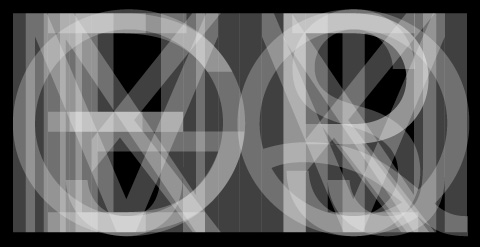Join MyVisit.to „Rauschen“
von Tobias Rehn, Archiv für Historische Abbildungspraxis, Köpenicker Str. 154, 10997 Berlin, 15:30 Uhr
© Tobias Rehn „IO, Rauschen, Mono, 14 dB“, 2008
Die Abschlussarbeit von Tobias Rehn zum Thema Rauschen beschäftigt sich, aufgrund der vielfältigen Konnotationen, die dem Begriff Rauschen zuzuschreiben sind, vorrangig mit der zentralen Frage, ob Sprache oder gar Schrift, das geschriebene Wort rauschen können.
Rauschen gilt oberflächlich betrachtet als ein chaotisches, ungeordnetes akustisches Phänomen, das durch Überlagerung mehrerer Geräusche und Laute entsteht. Wichtig hierbei ist, dass es nicht möglich ist, diesem diskrete, also unterscheidbare Laute zu entnehmen, und es so keinen Sinn beinhalten kann. Wie soll dann aber Schrift mit all dem durch sie transportierten Sinn rauschen können? Nach Friedrich Kittler ist dies nicht möglich, da mittels Schrift Laute gespeichert werden und dies Geräusche und somit auch Rauschen ausschließt.
Zur Beantwortung dieser Frage werden in der Arbeit Verweise an die Literatur der Romantik aufgeführt, in der man eine erste Blütezeit der Verwendung des Motivs des Rauschens in Texten findet. Über den Vergleich von verschiedenen Speicherformen für Musik, nämlich die Speicherung in Notenform, also in diskreten Zeichen – vergleichbar mit der Speicherung von Sprache in Textform – und der analogen Speicherung von Musik auf einer Schallplatte, sowie Anleihen aus der Akustik- und der Signaltheorie (dem weißen Rauschen und dem Signal-Rauschabstand) wird ein System entworfen, das es ermöglicht, Schrift rauschen zu lassen.
Über die Arbeit an diesem System und den Kommentaren hierzu reifte bei Tobias Rehn die Überlegung, dass die Erwartungshaltung, sowie die Absicht bei der Betrachtung des Phänomens Rauschen eine gewichtige Rolle spielen. Als Beispiel führt er in diesem Kontext ein Interview von John Cage an, in dem dieser sich unter anderem zu der Erwartung äußert, die er an „sounds“ hat und weiterhin erklärt, warum ihn der Klang des Verkehrs so fasziniert. Er benutzt in diesem Interview nie das Wort „noise“ – also Rauschen – was deutlich macht, dass es bei entsprechender Erwartungshaltung möglich ist, dass sich aus dem, was konventionell als Rauschen angesehen wird, Sinn ergibt; in diesem Fall Hörgenuss.
Aus diesen Überlegungen leitet Tobias Rehn eine weitere Frage ab, ob es aber gelingen kann, dass Rauschen als Inhalt wahrgenommen wird. Einen Versuch, dies zu erreichen, zeigt die Arbeit „Intros – Outros“. Diese besteht aus einer Schallplatte, auf der als Inhalt in dem Bereich der Rille, in dem normalerweise die Musikinformation zu finden ist, das Grundrauschen von 15 Schallplatten aufgezeichnet ist. So ist das Rillen-Grundgeräusch zum Signal bzw. Inhalt geworden, da die Entscheidung getroffen wurde, dieses bewusst an einem Ort zu platzieren, an dem sonst kein Rauschen erwartet wird, nämlich zwischen benannter Ein- und Auslaufrille einer Schallplatte.
Ob der auf dieser Schallplatte gespeicherte Inhalt jedoch als Rauschen angesehen wird, liegt wiederum an der Erwartungshaltung des Hörers. Und so zeigt sich, wie jeglicher Versuch der genaueren Betrachtung von Rauschen sein muss. Zum Einen ist man an spezifische Absichten gebunden, zum anderen scheint das, was man als Rauschen annimmt, in dem Moment, in dem man es zu fassen glaubt, sich seiner Gestalt des Chaotischen und Ungeordneten zu entledigen und nicht mehr wirklich Rauschen zu sein.









 Bild:
Bild:  Audio:
Audio:  PDF:
PDF: 





















 Jahr:
Jahr:  Ort:
Ort:  Messe:
Messe:  Farbe:
Farbe: 
